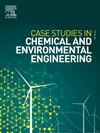Innovation in obtaining bacterial nanocellulose from banana rachis: Effects of ozone treatment
Q1 Environmental Science
Case Studies in Chemical and Environmental Engineering
Pub Date : 2024-12-17
DOI:10.1016/j.cscee.2024.101044
引用次数: 0
Abstract
The production of bananas generates considerable waste, including rachis, which can negatively impact the environment if not managed effectively. This study explores the potential of valorizing banana rachis, currently discarded, to produce bacterial nanocellulose (BNC), a bioproduct with applications in the textile, food, and cosmetic industries. The objective is to investigate the effect of different ozone treatment times (0, 5, 20, and 30 minutes) on the physicochemical properties of banana rachis juice (BRJ). The selected variables—dissolved oxygen, oxygen saturation, salinity, total dissolved solids, electrical conductivity, pH, turbidity, °Brix, and electrical resistance—are critical for influencing microbial growth and fermentation efficiency, essential for BNC production. The influence of varying BRJ concentrations (25 %, 50 %, and 75 %) and ozonation times on these properties and BNC yield was assessed. The BNC obtained from ozonated BRJ was characterized using Fourier transform infrared spectroscopy (FTIR), thermogravimetric analysis (TGA), and X-ray diffraction (XRD). Results indicated that the physicochemical properties of the BNC were consistent with those produced by the Hestrin-Schramm (HS) method, validating the reproducibility of these characteristics. A 25 % BRJ concentration treated with ozone for 20 minutes yielded approximately 0.88 g of dry BNC per liter after seven days of fermentation. This study provides an innovative solution for valorizing agro-industrial waste and suggests more sustainable waste management methods, with significant implications for both industry and the environment.

从香蕉茎中获得细菌纳米纤维素的创新:臭氧处理的效果
香蕉的生产会产生大量的废物,包括香蕉轴,如果不加以有效管理,可能会对环境产生负面影响。本研究探索了利用目前被丢弃的香蕉茎生产细菌纳米纤维素(BNC)的潜力,这是一种应用于纺织、食品和化妆品行业的生物制品。目的是研究不同臭氧处理时间(0、5、20和30分钟)对香蕉轴汁(BRJ)理化性质的影响。所选择的变量-溶解氧,氧饱和度,盐度,总溶解固体,电导率,pH值,浊度,白度和电阻-对影响微生物生长和发酵效率至关重要,对BNC生产至关重要。评估了不同BRJ浓度(25%、50%和75%)和臭氧化时间对这些性能和BNC产量的影响。利用傅里叶红外光谱(FTIR)、热重分析(TGA)和x射线衍射(XRD)对臭氧化BRJ得到的BNC进行了表征。结果表明,BNC的物理化学性质与Hestrin-Schramm (HS)方法的结果一致,验证了这些特征的重现性。25% BRJ浓度用臭氧处理20分钟,发酵7天后每升产生约0.88 g干BNC。本研究提供了一种创新的解决方案,以评估农业工业废物,并提出了更可持续的废物管理方法,对工业和环境都具有重要意义。
本文章由计算机程序翻译,如有差异,请以英文原文为准。
求助全文
约1分钟内获得全文
求助全文
来源期刊

Case Studies in Chemical and Environmental Engineering
Engineering-Engineering (miscellaneous)
CiteScore
9.20
自引率
0.00%
发文量
103
审稿时长
40 days
 求助内容:
求助内容: 应助结果提醒方式:
应助结果提醒方式:


